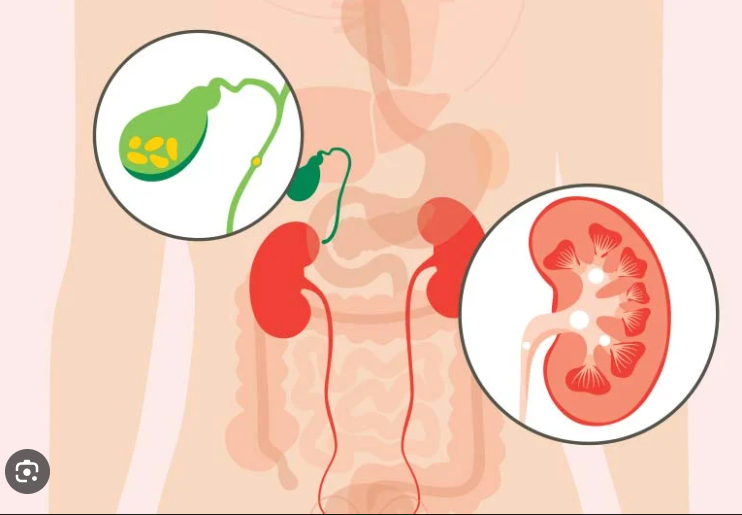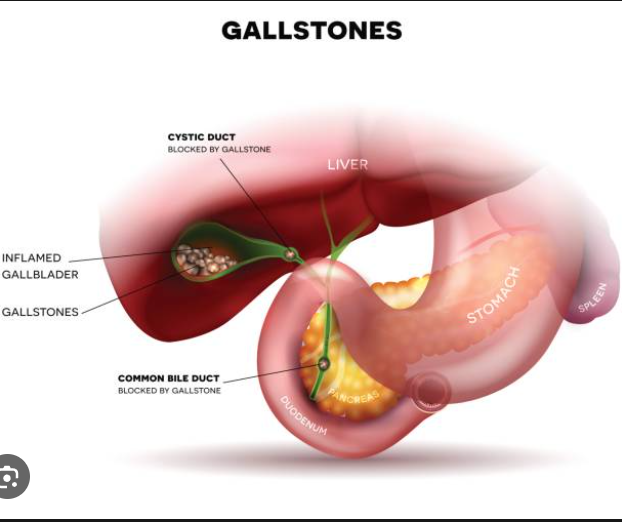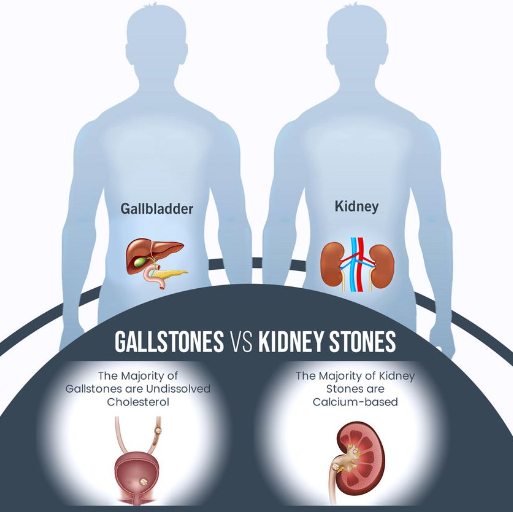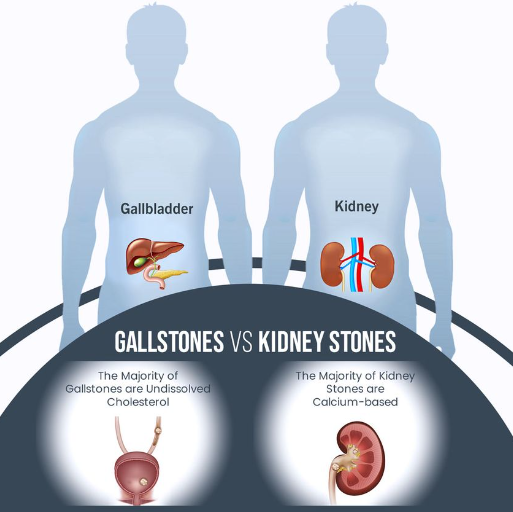The gallbladder and kidney solid, crystallized formations have different pain sites, diagnoses, and treatments.
Both kidney stones and gallstones, which are solid, crystallized growths that occur in the digestive and urinary tracts, respectively, can be extremely painful when they become lodged and restrict the normal passage of bile and urine.
Although both are known to induce abrupt, severe pain, scientists say there are a few characteristics that distinguish them.
What are gallstones?

Dr Veerendra R Koujalagi, consultant, gastroenterology and hepatology, Manipal Hospital, Hebbal, Bangalore, says gallstones are solid stones that form in one’s gallbladder — an organ located in the abdomen responsible for storing bile (a fluid that aids digestion).
“Bile, which forms in the liver, is particularly required for fat digestion. It is released by the gallbladder as and when required by the [digestive] system,” says Dr Penmetsa Vijay Varma, consultant nephrologist at Yashoda Hospitals, Hyderabad.
“The stones usually form whenever there is excess bilirubin [bile pigment] or cholesterol in the gallbladder. They get deposited in the gall bladder along with the bile and crystalize, leading to the formation of gallbladder stones,” explains Dr Koujalagi.
Gallstones can be as big as golf balls, according to the US National Institute of Diabetes and Digestive and Kidney Diseases (NIDDK).
What are kidney stones?

According to Dr. Varma, kidney stones are solid, crystalline particles that form inside the kidney. They may develop at the kidney and become displaced into the ureter or urinary system. Every time a kidney stone becomes stuck in the urinary drain, it causes an obstruction and causes excruciating discomfort, said the doctor.
The NIDDK states that kidney stones can be as little as a pea or as large as a sand grain.
Symptoms of gallstones

According to Dr. Varma, people with kidney or gallstones may have certain related symptoms, such as fever, vomiting, etc.
Gallstone symptoms can include:
chills and a fever
Diarrhea and nausea
Upper right abdominal pain that frequently comes on after eating. Jaundice might frequently radiate to your back.
Gallstones, however, can frequently be asymptomatic and are typically found during a routine ultrasound scan, according to Dr. Koujalagi.
Symptoms of kidney stones
Some common symptoms of kidney stones include:
- Fever and chills
- Nausea
- Vomiting
- Sharp pain in the side and back (below the ribs), which can radiate to the lower abdomen and groin area
- Foul-smelling urine
Gallstones and kidney stones: Who’s at risk?

Dr Koujalagi says, “Traditionally, we believed that gallstones were more common among women in their 40s, who have had multiple childbirths, are obese and are of Caucasian descent. However, this doesn’t mean they won’t affect men and women of other age groups.”
He further notes that rapid weight loss can also lead to the formation of gallstones, as extra cholesterol is released into the bile while one’s body metabolizes fat. Elevated hormones during pregnancy also lead to elevated cholesterol levels in the bile, causing gallstones to develop in pregnant women. Speaking about gallstones in children, he cautions that those diagnosed must get screened for any underlying blood disorders.
Treating gallstones

Dr Koujalagi says if a gallstone is detected during a routine health checkup but the individual does not show any symptoms and has normal liver function, immediate treatment may not be necessary. “One has to watch out for warning signs like upper abdominal pain and vomiting. In such a scenario, one must consult a gastroenterologist who will carry out the diagnosis and take a call on how to treat it based on its location,” he explains.
Treating kidney stones
Dr Varma says when it comes to kidney stones, the smaller ones (less than 6 mm) usually have a higher chance of passing through one’s system naturally. “Sometimes, kidney stones can get stuck in the junction between one’s ureter and bladder. In such cases, surgery may be required,” he adds.
Common treatment options available for treating larger kidney stones include laser lithotripsy, where a larger kidney stone is broken down into smaller pieces using a laser and percutaneous nephrolithotomy (PCNL), where a small incision is made in the back to access the kidneys and remove the stones.
Preventing gallstones and kidney stones
Dr Koujalagi says preventing gallstones usually involves maintaining a well-balanced diet, an ideal body weight and a healthy lifestyle. “Rapid weight loss resulting from excessive fasting or dieting can increase your risk for gallstones. Hence, maintaining an ideal body weight through a balanced diet can help prevent their occurrence,” he adds.
Getting enough water in your system, according to Dr. Varma, is essential for kidney stone prevention. “At least 2-3 liters of water should be consumed throughout the day. They cannot drink a liter in the morning and another in the evening and believe that their hydration requirements have been satisfied, he continues.
Takeaways
- Gallstones are solid stones that form in one’s gallbladder, while kidney stones are solid, crystallized substances that are formed within the kidney. Gallstones can cause an obstruction in the digestive system, while kidney stones can get dislodged into the urinary pipe or the ureter, causing obstruction and pain.
- Symptoms of gallstones and kidney stones include fever, chills, vomiting and pain in the upper right abdomen as well as below the ribs.
- Both types of stones can be prevented by following a balanced diet, maintaining an ideal body weight through an active lifestyle and ensuring adequate hydration.
also read-5 Ayurvedic Remedies For Heel Pain
images source-google




































